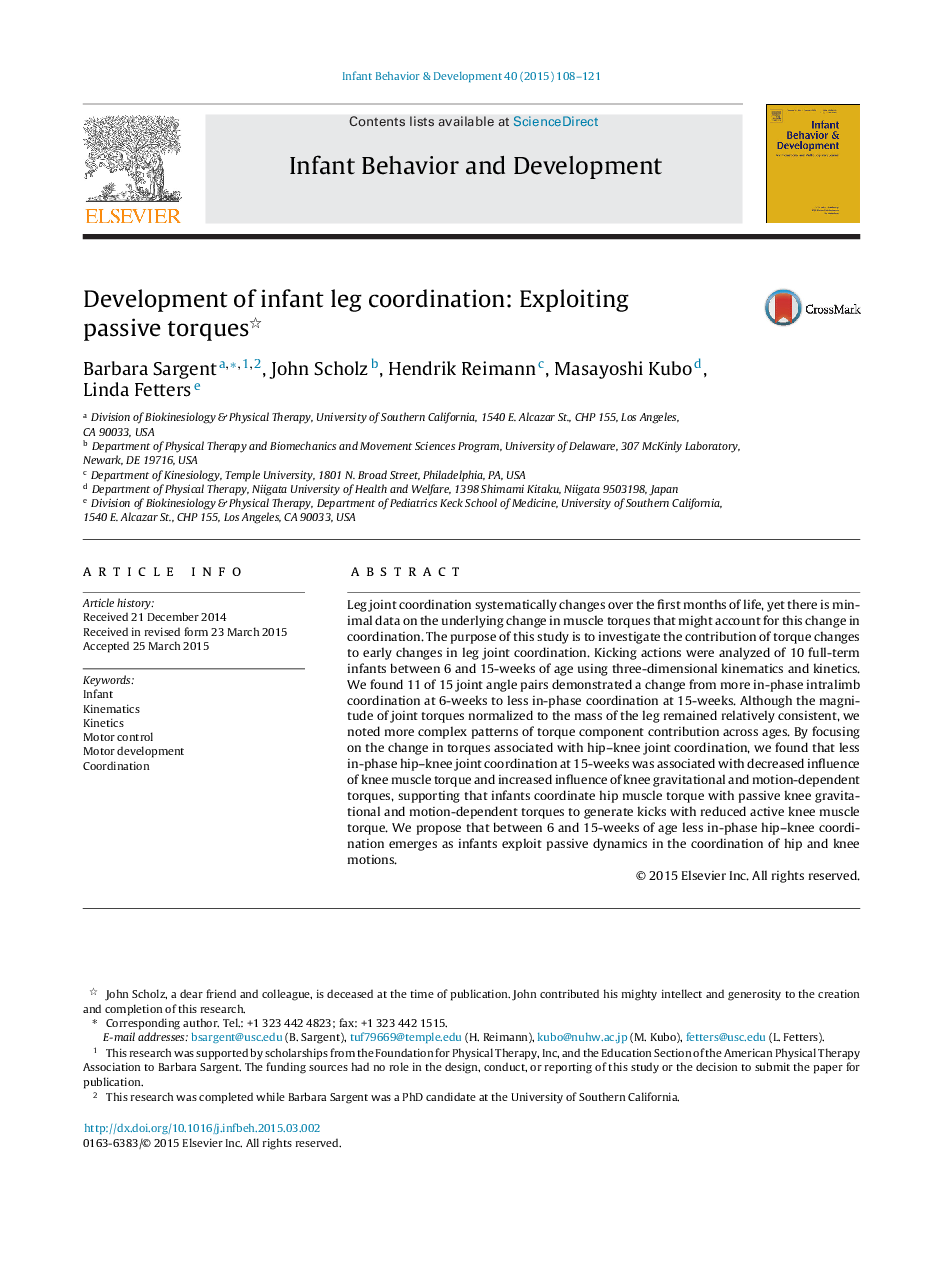| کد مقاله | کد نشریه | سال انتشار | مقاله انگلیسی | نسخه تمام متن |
|---|---|---|---|---|
| 7273320 | 1473420 | 2015 | 14 صفحه PDF | دانلود رایگان |
عنوان انگلیسی مقاله ISI
Development of infant leg coordination: Exploiting passive torques
ترجمه فارسی عنوان
توسعه هماهنگی پایه نوزادان: بهره گیری از گشتاور های منفعل
دانلود مقاله + سفارش ترجمه
دانلود مقاله ISI انگلیسی
رایگان برای ایرانیان
کلمات کلیدی
ترجمه چکیده
هماهنگی همگانی پایه در طول ماههای اول زندگی تغییر می کند، با این حال، اطلاعات کمتری در مورد تغییرات اساسی در گشتاور عضلانی وجود دارد که ممکن است این تغییر در هماهنگی را داشته باشد. هدف از این مطالعه بررسی نقش تغییرات گشتاور در تغییرات اولیه در هماهنگی مفصل پایه است. اقدامات لیک کردن از 10 نوزاد کامل در سن 6 تا 15 هفته با استفاده از سینماتیک و جنبشی سه بعدی مورد تجزیه و تحلیل قرار گرفت. ما 11 از 15 جفت زاویه مشترک را پیدا کردیم که از هماهنگی بیشتر در فاز نیمهالمپیم در 6 هفته تا کمترین هماهنگی در 15 هفته تغییر کرد. گرچه مقدار گشتاور های مشترک، به طور معمول به جرم پای ثابت باقی مانده، نسبتا سازگار باقی مانده است، ما الگوهای پیچیده ای از مشارکت مؤلفه گشتاور در طول سنین را ذکر کردیم. با توجه به تغییر در گشتاور های مرتبط با هماهنگی مفصلی مفصل ران، متوجه شدیم که هماهنگی مفصل همجنسگرایان در فاز کمتر از 15 هفته با کاهش تاثیر گشتاور عضلانی زانو و افزایش تاثیر گرانشی زانو و حرکت وابسته گشتاور، حمایت از آن نوزادان، گشتاور عضلانی گام را با گشتاور های گرانشی زانو و حرکت به هم متصل می کند تا لگن را با گشتاور عضله فعال زانو فعال کند. ما پیشنهاد می کنیم که بین سن 6 تا 15 سالگی، کمترین هماهنگی هماهنگی هیپ-زانو، به نظر می رسد زیرا نوزادان از پویایی منفعل در هماهنگی حرکات هیپ و زانو بهره می گیرند.
موضوعات مرتبط
علوم زیستی و بیوفناوری
علم عصب شناسی
علوم اعصاب رفتاری
چکیده انگلیسی
Leg joint coordination systematically changes over the first months of life, yet there is minimal data on the underlying change in muscle torques that might account for this change in coordination. The purpose of this study is to investigate the contribution of torque changes to early changes in leg joint coordination. Kicking actions were analyzed of 10 full-term infants between 6 and 15-weeks of age using three-dimensional kinematics and kinetics. We found 11 of 15 joint angle pairs demonstrated a change from more in-phase intralimb coordination at 6-weeks to less in-phase coordination at 15-weeks. Although the magnitude of joint torques normalized to the mass of the leg remained relatively consistent, we noted more complex patterns of torque component contribution across ages. By focusing on the change in torques associated with hip-knee joint coordination, we found that less in-phase hip-knee joint coordination at 15-weeks was associated with decreased influence of knee muscle torque and increased influence of knee gravitational and motion-dependent torques, supporting that infants coordinate hip muscle torque with passive knee gravitational and motion-dependent torques to generate kicks with reduced active knee muscle torque. We propose that between 6 and 15-weeks of age less in-phase hip-knee coordination emerges as infants exploit passive dynamics in the coordination of hip and knee motions.
ناشر
Database: Elsevier - ScienceDirect (ساینس دایرکت)
Journal: Infant Behavior and Development - Volume 40, August 2015, Pages 108-121
Journal: Infant Behavior and Development - Volume 40, August 2015, Pages 108-121
نویسندگان
Barbara Sargent, John Scholz, Hendrik Reimann, Masayoshi Kubo, Linda Fetters,
